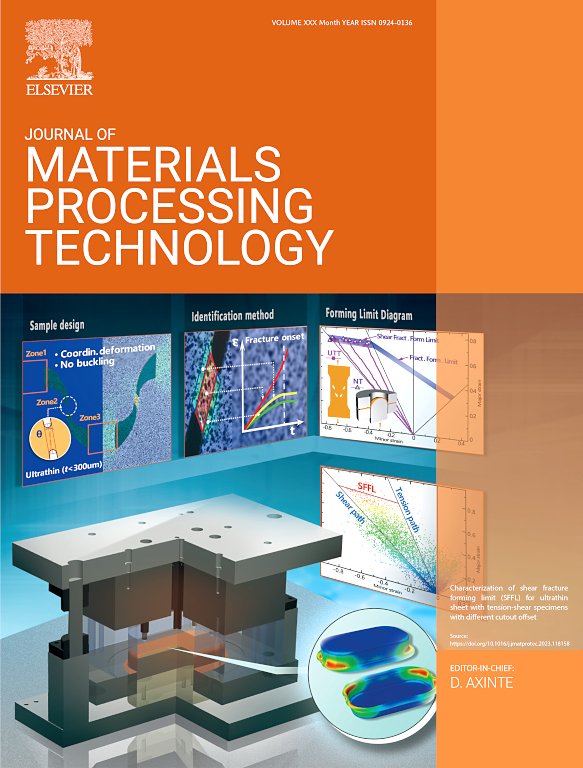Multiscale simulation and experimental study on ultrasonic vibration assisted machining of SiCp/Al composites considering acoustic softening
IF 6.7
2区 材料科学
Q1 ENGINEERING, INDUSTRIAL
Journal of Materials Processing Technology
Pub Date : 2024-11-02
DOI:10.1016/j.jmatprotec.2024.118649
引用次数: 0
Abstract
Ultrasonic vibration assisted machining (UVAM) is an attractive option to achieve high-quality and low-wear machining of the advanced composites. The scope of this paper is to evaluate the role of ultrasonic vibration on the microstructure and material removal mechanism for SiCp/Al composites. Firstly, an ultrasonic vibration assisted tension (UVAT) molecular dynamics (MD) simulation method for SiCp/Al composites is proposed. The simulation results verify the existence of acoustic softening effect for SiCp/Al composites under ultrasonic vibration loads. Furthermore, it is found that the acoustic softening originates from the dynamic evolution of the dislocations in the Al matrix. However, the acoustic softening is hardly mentioned in conventional finite element (FE) simulations depicting the microscopic removal mechanism of materials. In this paper, the constitutive correction method is adopted to realize it. The stress reduction of the Al matrix caused by acoustic softening is reverse-identified, and the maximum is 102 MPa. Finally, a novel FE model for UVAM of SiCp/Al composites considering acoustic softening is constructed, and the microscopic removal mechanism of SiCp/Al composites is revealed by the FE simulation and microscopic experimental results. On the one hand, the ultrasonic vibration enhances the stress relaxation of the Al matrix by reducing the dislocation density, and further enhances the deformation ability of SiCp/Al composites. On the other hand, the matrix tearing dominates the generation and propagation of shear band cracks in conventional machining (CM), while the dominant factor in UVAM is the finely broken SiC particles inside the shear band. This study enhances the understanding of the microscopic removal mechanism in UVAM for SiCp/Al composites.
考虑声学软化的 SiCp/Al 复合材料超声波振动辅助加工的多尺度模拟和实验研究
超声波振动辅助加工(UVAM)是实现先进复合材料高质量、低磨损加工的一种极具吸引力的选择。本文的研究范围是评估超声振动对 SiCp/Al 复合材料微观结构和材料去除机制的作用。首先,本文提出了一种针对 SiCp/Al 复合材料的超声振动辅助拉伸(UVAT)分子动力学(MD)模拟方法。模拟结果验证了 SiCp/Al 复合材料在超声波振动载荷下存在声学软化效应。此外,还发现声学软化源于铝基体中位错的动态演化。然而,在描述材料微观去除机制的传统有限元(FE)模拟中,几乎没有提到声软化。本文采用构成修正法来实现它。反向识别了声软化导致的铝基体应力降低,最大值为 102 兆帕。最后,构建了考虑声软化的 SiCp/Al 复合材料 UVAM 的新型 FE 模型,并通过 FE 仿真和微观实验结果揭示了 SiCp/Al 复合材料的微观去除机理。一方面,超声振动通过降低位错密度增强了铝基体的应力松弛,进一步提高了 SiCp/Al 复合材料的变形能力。另一方面,在传统加工(CM)中,基体撕裂是剪切带裂纹产生和扩展的主要因素,而在 UVAM 中,剪切带内细小破碎的 SiC 颗粒是主要因素。这项研究加深了人们对 SiCp/Al 复合材料 UVAM 中微观去除机制的理解。
本文章由计算机程序翻译,如有差异,请以英文原文为准。
求助全文
约1分钟内获得全文
求助全文
来源期刊

Journal of Materials Processing Technology
工程技术-材料科学:综合
CiteScore
12.60
自引率
4.80%
发文量
403
审稿时长
29 days
期刊介绍:
The Journal of Materials Processing Technology covers the processing techniques used in manufacturing components from metals and other materials. The journal aims to publish full research papers of original, significant and rigorous work and so to contribute to increased production efficiency and improved component performance.
Areas of interest to the journal include:
• Casting, forming and machining
• Additive processing and joining technologies
• The evolution of material properties under the specific conditions met in manufacturing processes
• Surface engineering when it relates specifically to a manufacturing process
• Design and behavior of equipment and tools.
 求助内容:
求助内容: 应助结果提醒方式:
应助结果提醒方式:


